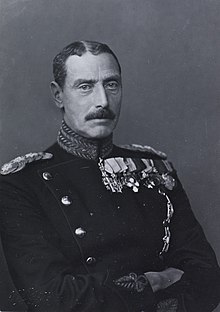
Back Christiaan X van Denemarke Afrikaans Christian X Dēna Cyning ANG كريستيان العاشر ملك الدنمارك Arabic كريستيان العاشر ARZ Cristian X de Dinamarca AST X Kristian Azerbaijani اوْنونجو کریستیان (دانمارک) AZB Крысціян X Byelorussian Кристиан X Bulgarian Kristijan X, kralj Danske BS
| Christian X | |||||
|---|---|---|---|---|---|
 Christian X by Peter Elfelt | |||||
| King of Denmark | |||||
| Reign | 14 May 1912 – 20 April 1947 | ||||
| Predecessor | Frederick VIII | ||||
| Successor | Frederik IX | ||||
| King of Iceland | |||||
| Reign | 1 December 1918 – 17 June 1944 | ||||
| Born | 26 September 1870 Charlottenlund Palace, Copenhagen, Denmark | ||||
| Died | 20 April 1947 (aged 76) Amalienborg Palace, Copenhagen, Denmark | ||||
| Burial | Roskilde Cathedral, Roskilde, Denmark | ||||
| Spouse | |||||
| Issue | |||||
| |||||
| House | Glücksburg | ||||
| Father | Frederick VIII of Denmark | ||||
| Mother | Louise of Sweden | ||||
| Religion | Church of Denmark | ||||
| Signature | |||||
Christian X (Danish: Christian Carl Frederik Albert Alexander Vilhelm; 26 September 1870 – 20 April 1947) was King of Denmark from 1912 until his death in 1947. He was also the only King of Iceland as Kristján X, holding the title as a result of the personal union between Denmark and independent Iceland between 1918 and 1944.
He was a member of the House of Glücksburg, a branch of the House of Oldenburg, and the first monarch since King Frederick VII born into the Danish royal family; both his father and his grandfather were born as princes of a ducal family from Schleswig. Among his siblings was King Haakon VII of Norway. His son became Frederick IX of Denmark. Among his cousins were King George V of the United Kingdom, Emperor Nicholas II of Russia, and King Constantine I of Greece, while Queen Maud of Norway, was both his cousin and sister-in-law.
His character has been described as authoritarian and he strongly stressed the importance of royal dignity and power. His reluctance to fully embrace democracy resulted in the Easter Crisis of 1920, in which he dismissed the democratically elected Social Liberal cabinet with which he disagreed, and installed one of his own choosing. This was in accordance with the letter of the constitution, but the principle of parliamentarianism had been considered a constitutional custom since 1901. Faced with mass demonstrations, a general strike organized by the Social Democrats and the risk of the monarchy being overthrown he was forced to accept that a monarch could not keep a government in office against the will of parliament, as well as his reduced role as a symbolic head of state.
During the German occupation of Denmark, Christian became a popular symbol of resistance, particularly because of the symbolic value of the fact that he rode every day through the streets of Copenhagen unaccompanied by guards. With a reign spanning two world wars, and his role as a rallying symbol for Danish national sentiment during the German occupation, he became one of the most popular Danish monarchs of modern times.
© MMXXIII Rich X Search. We shall prevail. All rights reserved. Rich X Search